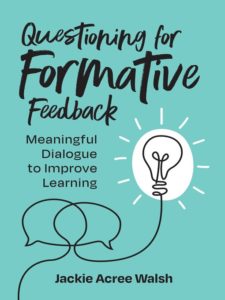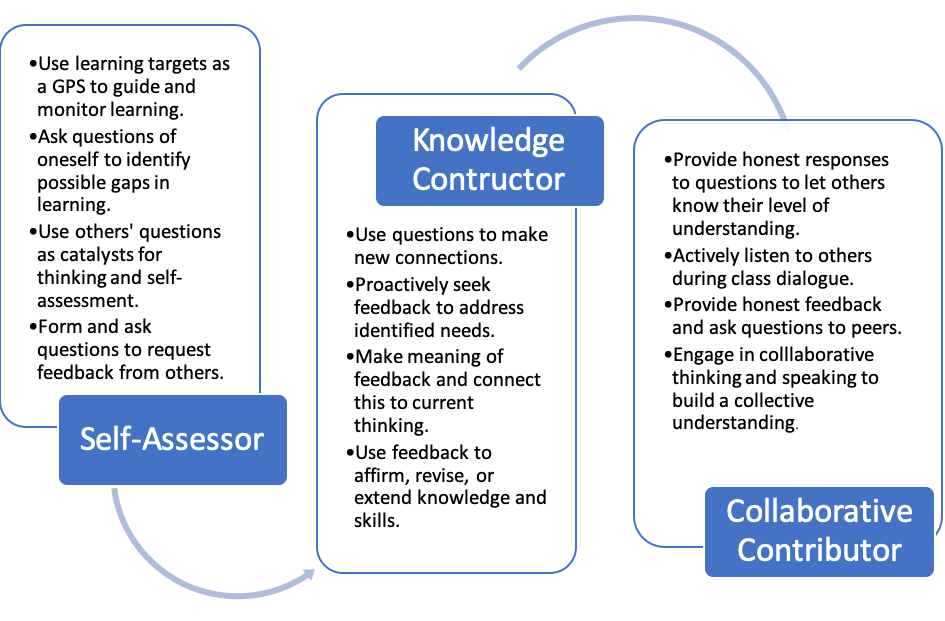Keys to Questioning for Formative Feedback
Questioning for Formative Feedback: Meaningful Dialogue to Improve Learning
By Jackie Acree Walsh
(ASCD, 2022 – Learn more)
Reviewed by Kathleen Palmieri

I have long believed that classroom discussions lead to greater learning, and in this new ASCD book Walsh offers ideas, tips and strategies, as well as sample prompts, all supported by her research on the importance of meaningful dialogue in the classroom.

It is Walsh’s contention (and I agree) that we need to modify the traditional ways questioning has been used in the classroom if we are to achieve “productive dialogue.”
This includes changing or modifying the traditional classroom roles of the teacher and the student in how questioning occurs – moving from coming up with the “right” answer to a “deep learning orientation.”
As Walsh demonstrates throughout the book, learning isn’t about coming up with the right answer as your response. Rather learning is about exploration – engaging in meaningful discussion to discover new learning and understanding.
This book is broken into four parts: framing the process, developing student capacity, designing formative experiences, and advancing engagement and learning. Each part is like a mini-course, and each builds upon the other to offer an authentic approach to improving dialogue in the classroom to achieve increased student learning.
Cornerstone Beliefs
Questioning, dialogue, and formative feedback are the underlying processes that are part of the “themes that serve as cornerstone beliefs.” A few of these recurring themes include developing self-regulated learners and helping students to be partners in changing classroom engagement practices; recognizing how important it is for teachers to plan ahead for effective questioning and dialogue; and strengthening our skills at providing quality formative feedback.
Walsh believes that “Teachers who plan for intentional activation of each of their daily lessons enable their students to experience ‘golden moments’ in learning on a routine basis.” (p. 10) This thought – the idea that we can achieve routine ‘golden learning moments’ – rings throughout every part and chapter of this book.
Student Roles and Responsibilities
in the Formative Classroom
Source: Questioning for Formative Feedback, by Jackie A. Walsh, ASCD, 2022, p. 89.
A Wide Range of Resources
Among the resources provided are “Classroom Artifacts” such as videos from a variety of grades/classrooms, QR codes, and work products from teachers and students. Also included are blueprints that offer an infographic look at key processes. An example is Figure 1.3 offering a blueprint for “Designing and Orchestrating Formative Feedback” on p. 28.
Tools in the form of charts are interwoven throughout such as figure 0.2 on p. 11 that offers a springboard to “Transferring Principles to Practice: Setting the Stage.” This chart offers “opportunities for practice beginning with the why, reflecting on the cornerstone beliefs” as well as to “assess relevance and importance of focus areas.” In addition, it provides “teacher learning” and “teacher facilitation of student learning” questions and ideas to consider.
Chapter 5 is jam-packed and dives deep into the aspects of different questions that produce engagement of learners. Graphical features such as figure 5.1 “Taxonomy of Formative Questions,” and the extensive chart in figure 5.2 offering “Criteria for Questions That Stimulate Thinking and Produce Feedback for Teachers” provide great opportunities for a teacher to deep dive into their current practice and consider modifications.
“Types of Focus Questions” offers questions that activate prior knowledge to generate feedback related to surface learning and deep knowledge, along with the process and steps to formulating effective follow-up questions. Included is a “Template for Preparing Follow-up Questions” that can be used to plan.
In addition to the 21 videos offered throughout this book, the appendix offers a QR code to the entire playlist of videos with a brief introduction from Walsh.
Students’ Questions
The discussion on “Student Questions,” which Walsh defines as “the richest – but least exploited – source of feedback,” includes emerging questions, self-questions, and academic questions. More excellent resources are found in figure 5.8 “Prompts and Stems to Support Academic Questions.” (pp. 131-132), figure 5.9 “Prompts and Stems to Support Dialogic Questions (p. 134) and figure 5.10 “Transferring Principles to Practice: Questions.” (pp. 135-137)
A Great Professional Learning Adventure
Questioning for Formative Feedback is full of insightful, thought provoking, and practical ways to infuse a classroom with formative questioning, encourage dialogue, and lead to deeper learning for students. This book is a great professional learning adventure as we prepare to transform questioning and feedback in our classrooms.
Kathleen Palmieri is a National Board Certified Teacher and NBCT Professional Learning facilitator. She is a fifth grade educator in upstate New York who reviews and writes regularly for MiddleWeb. With a passion for literacy and learning in the classroom, she participates in various writing workshops, curriculum writing endeavors, and math presentations. As a lifelong learner, she is an avid reader and researcher of educational practices and techniques. Collaborating with colleagues and globally on Twitter @Kathie042500 and expanding her education adventures at www.kathleenpalmieri.com are an ongoing practices.




































Thank you, Kathleen, for your thoughtful review of my book! You captured the essence of the book—and made me want to read it 😊 My hope is that the book will support you and many other educators in harnessing the power of questioning in the service of learning for students and teachers.
It was my pleasure to read and review your book. I very much appreciate all of the practical strategies, examples, and the many resources you’ve provided. Thank you!
Who says there is nothing new to learn about asking questions? Jackie Walsh always provides a fresh lens to things we thought we knew. I especially liked the figure on p. 89 illustrating student roles when generating questions that drive their learning.
Karin, thank you for your endorsement. I respect and refer to your work often. I believe it to be critical to teach students the skills that can enable them to assume these three critical roles.
Your strategies fit beautifully within my Actionable Assessment Cycle https://www.karin-hess.com/_files/ugd/5e86bd_01d355cf0d4b465c8fc1a41d9804bc11.pdf. We need to find ways collaborate …